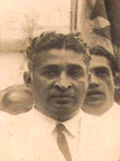1952 Ceylonese parliamentary election
| |||||||||||||||||||||||||||||||||||||||||||||
95 seats to the House of Representatives of Ceylon 48 seats were needed for a majority | |||||||||||||||||||||||||||||||||||||||||||||
|---|---|---|---|---|---|---|---|---|---|---|---|---|---|---|---|---|---|---|---|---|---|---|---|---|---|---|---|---|---|---|---|---|---|---|---|---|---|---|---|---|---|---|---|---|---|
| |||||||||||||||||||||||||||||||||||||||||||||
| |||||||||||||||||||||||||||||||||||||||||||||
General elections were held in Ceylon (now Sri Lanka) in 1952. It is notable for being the second and final election overseen and administered by the Department of Parliamentary Elections before its merger in 1955.[1]
Background
Prime Minister D.S. Senanayake died in March 1952, and was succeeded by his son, Dudley. The national wave of mourning for Ceylon's first prime minister greatly boosted the UNP's fortunes.
The 1952 election was the first contested by the Sri Lanka Freedom Party, which had broken away from the UNP on a platform of Sinhala nationalism, and the Illankai Tamil Arasu Kachchi (Federal Party), which split from the All Ceylon Tamil Congress over joining the UNP government.
Results
Because the estate Tamils had been stripped of their citizenship by the Senanayake government, the Ceylon Indian Congress, which most of them had supported, was eliminated from Parliament and the Lanka Sama Samaja Party lost seats. The UNP won a majority, mainly at the cost of the CIC and the LSSP.[citation needed]
| Party | Candidates | Votes | % | Seats | |
|---|---|---|---|---|---|
| style="background-color:Template:United National Party/meta/color" | | United National Party | 81 | 1,026,005 | 44.08% | 54 |
| style="background-color:Template:Sri Lanka Freedom Party/meta/color" | | Sri Lanka Freedom Party | 48 | 361,250 | 15.52% | 9 |
| style="background-color:Template:Lanka Sama Samaja Party/meta/color" | | Lanka Sama Samaja Party | 39 | 305,133 | 13.11% | 9 |
| style="background-color:Template:Communist Party of Ceylon/meta/color" | | Communist Party of Ceylon / Viplavakari Lanka Sama Samaja Party |
19 | 134,528 | 5.78% | 4 |
| style="background-color:Template:All Ceylon Tamil Congress/meta/color" | | All Ceylon Tamil Congress | 7 | 64,512 | 2.77% | 4 |
| style="background-color:Template:Illankai Tamil Arasu Kachchi/meta/color" | | Illankai Tamil Arasu Kachchi | 7 | 45,331 | 1.95% | 2 |
| style="background-color:Template:Ceylon Labour Party/meta/color" | | Ceylon Labour Party | 5 | 27,096 | 1.16% | 1 |
| Republican Party | 9 | 33,001 | 1.42% | 0 | |
| Buddhist Republican Party | 3 | 3,987 | 0.17% | 0 | |
| style="background-color:Template:Independent politician/meta/color" | | Independents | 88 | 326,783 | 14.04% | 12 |
| Valid Votes | 306 | 2,327,626 | 100.00% | 95 | |
| Rejected Votes | |||||
| Total Votes Polled | |||||
| Total Electors Polled[a] | 2,114,615 | ||||
| Registered Electors | 2,990,912 | ||||
| Turnout | 70.70% | ||||
Notes
- ^ Total electors polled is less than total votes polled due to multiple-member seats where electors can cast more than one vote.
References
- ^ "Elections Department in the limelight". ft.lk. Daily Financial Times. 3 October 2015. Retrieved 4 February 2018.
- ^ "Table 32 Parliament Election (1952)". Sri Lanka Statistics. 10 February 2009.
- "Result of Parliamentary General Election 1952" (PDF). Department of Elections, Sri Lanka. Archived from the original (PDF) on 24 September 2015.
- "1952 General Election Results". LankaNewspapers.com. Archived from the original on 10 March 2012.
- "Table 32 Parliament Election (1952)". Sri Lanka Statistics. 10 February 2009.
- Rajasingham, K. T. (10 November 2001). "Chapter 14: Post-colonial realignment of political forces". Asia Times. Sri Lanka: The Untold Story.


